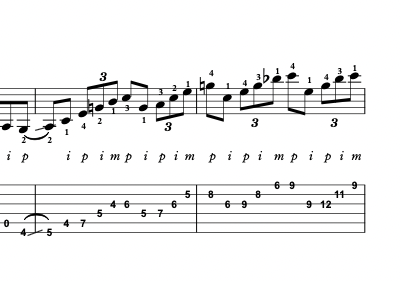Middle Finger (Right Hand)
-
Hi Emil, I am working my way through this lesson and it is great. Really enjoying it. You mentioned at the start about using your right-hand index and thumb (with a bit of your middle finger). I notice you use your right middle finger on the banjo rolls, but almost always use the alternating Thumb-Index for your runs/lick. My question is on three note runs (same string, to the next string, either descending or ascending) do you stick to the Thumb-Index exclusively? I learned some lines from Chet that had middle-index-thumb etc. Hope this makes sense. Thanks, Marc
-
@marcd
Hi Marc!
Thank you so much for checking out the "Right Hand Technique" lesson!Yes, I use mainly the index finger & thumb pick for the single note lines/licks but I use the middle finger for rolls, open string runs, some triplet runs etc.
If you're asking about those triplet runs where I play same string twice and then next string, and next string again - the order is this:The 1st note is played using index finger,
2nd note (same string) is played with the thumb pick
then we play index finger on the next string,
then middle finger on the next string,
then ring finger on the next string,
and finally ending with the thumb pick on the same string.This might be a bit confusing explained this way, so here's a TAB for a lick that I use at 0:57 in this video: "Cowboy Solo"
Make sure to look at the right hand fingerings, and slow down the video. (By the way, this is part of the lesson "Open String Licks Vol.2" if you'd like to check it out. I slowly walk through all the techniques and ideas in that video)
p=thumb, i=index finger, m=middle finger, a=ring finger...

Regarding the descending triplet runs, I actually use the index finger to "sweep" across two strings. Se this lick and link:
"Reel Lick #22"Let me know if this answered your question! I'm always here to help!
Kind regards/Emil
-
Hi Emil! Thank you so much for the reply. Here is some tab that perhaps better describes my question. This is how I learned three note single string runs. My guess is that you play these kinds of runs with alternate thumb-index, no matter if the last note is an upstroke (Index) and the next note (bottom string) is a down stroke . I am working on using your slide technique but I am also trying this in a new-to-me way. Have a great day.
Marc
-
@marcd
Hi!!
Thanks for describing it like this - it's very clear what you mean now.
Awesome! This technique that you're describing was frequently used by Chet Atkins, Lenny Breau and others in the same style. It is a really great technique that I strongly recommend you to explore! I've used it too, but not enough! :) It's more commonly heard by nylon string players - for instance, I've heard the great Richard Smith use this "p m i"- pattern many times.Check out this video at 1:42, where Chet Atkins is using the technique in the song "Cascade". There are SO many techniques and ideas to learn from in this video!!
So to answer your question; I'm actually not using this technique a lot since I feel that I can reach the same speed using only alternating between thumb/fingers - and I feel that its easy to get stuck when playing this technique on steel string guitars. On nylon it's much easier for me! But I need more practice! :)
Also, check out the lick at 0:42 in the video above (Chet Atkins playing Cascade), where he's using the "p m i"-technique when playing a descending line (3 notes per string).. It works great on descending lines. He's basically just playing a C major scale from the 3rd of the scale (note E) on the high E string, and playing the scale all the way down to the low A note on the low E string.. :)
Have a great day!
/E
Have a wonderful dat!
